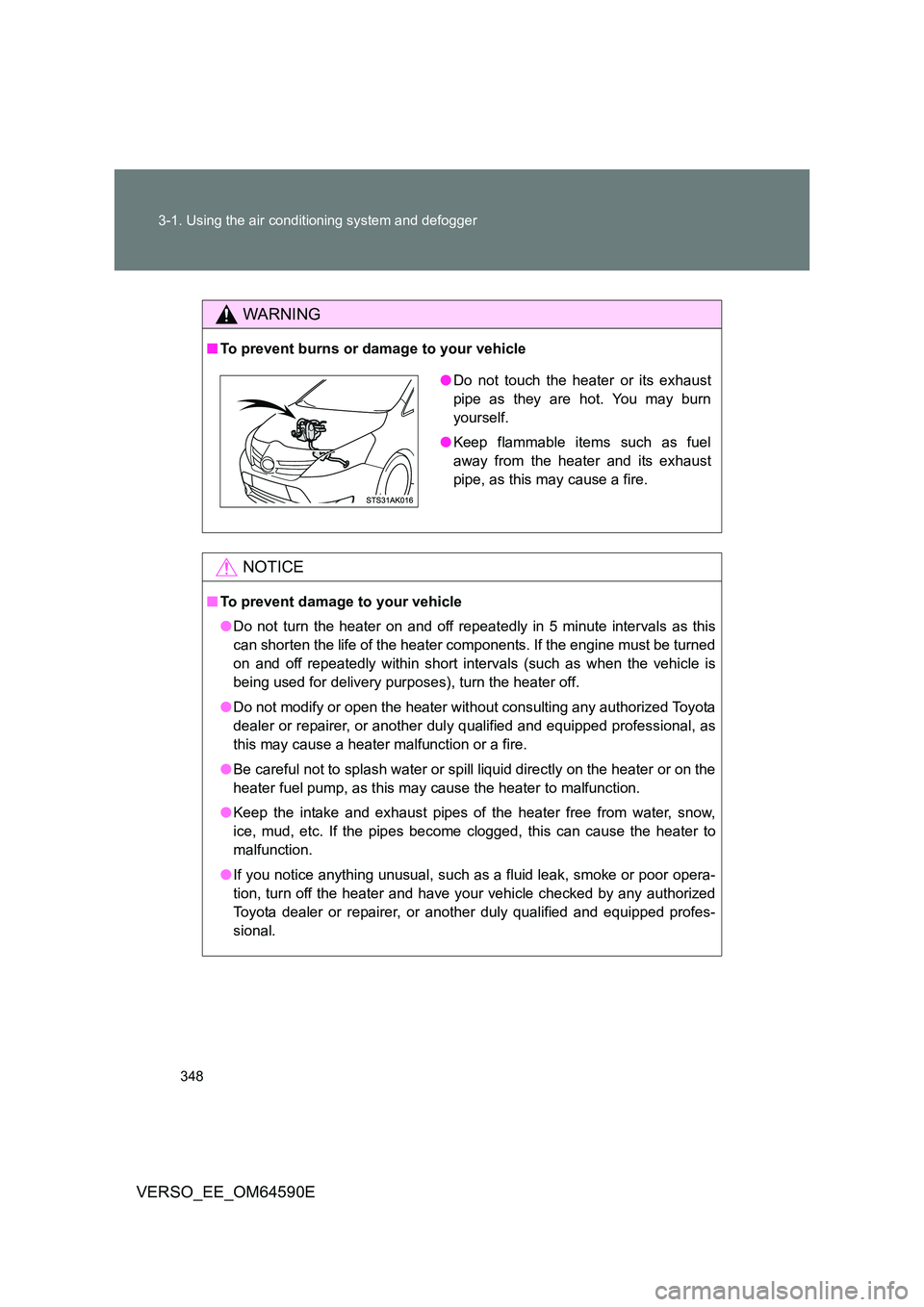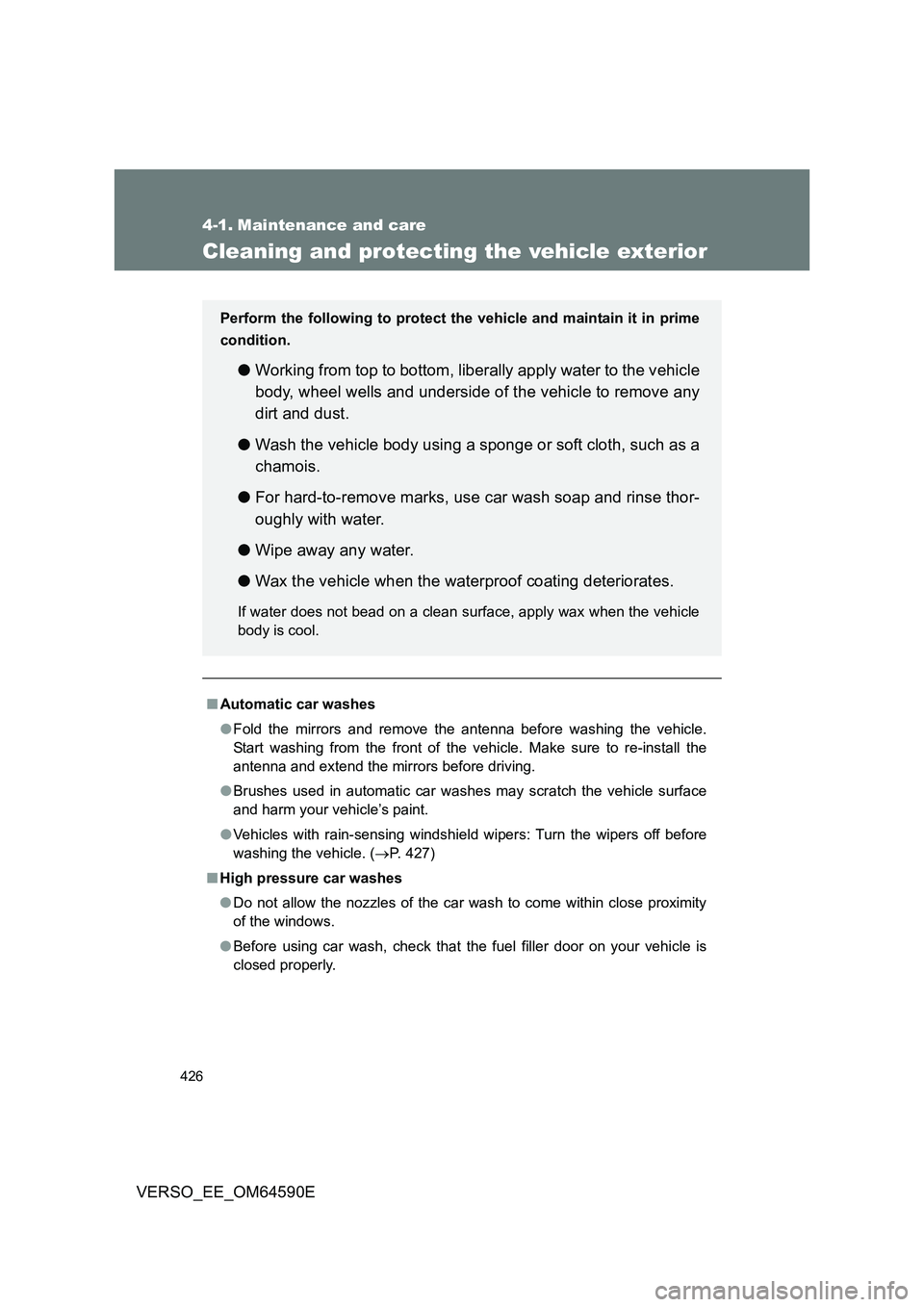Page 246 of 664
246
2-2. Instrument cluster
VERSO_EE_OM64590E
Past record (navigation/multimedia system)
Press the button on the navi-
gation/multimedia system.
Select “Past record”.
Best recorded fuel consump-
tion
Previous fuel consumption
record
Average fuel consumption
Updating the average fuel
consumption data
Resetting the past record data
The average fuel consumption history is divided by color into past
averages and the average fuel consumption since the last
updated. Use the displayed average fuel consumption as a refer-
ence.
These images are examples only, and may vary slightly from actual con-
ditions.
Page 247 of 664
247
2-2. Instrument cluster
2
When driving
VERSO_EE_OM64590E
■ Updating the past record data
Update the average fuel consumption by selecting “Update” to measure the
current fuel consumption again.
■ Resetting the data
The fuel consumption data can be deleted by selecting “Clear”.
■ Cruising range
Displays the estimated maximum distance that can be driven with the quan-
tity of fuel remaining.
This distance is computed based on your average fuel consumption.
As a result, the actual distance that can be driven may differ from that dis-
played.
Page 317 of 664
317
2
When driving
VERSO_EE_OM64590E
2-6. Driving information
Cargo and luggage
WARNING
■Things that must not be carried in the luggage compartment
The following things may cause a fi re if loaded in the luggage compartment.
● Receptacles containing gasoline
● Aerosol cans
Take notice of the following information about storage precautions,
cargo capacity and load.
● Stow cargo and luggage in the luggage compartment whenever
possible.
● Be sure all items are secured in place.
● Be careful to keep the vehicle level. Placing the weight as far for-
ward as possible helps maintain vehicle balance.
● For better fuel economy, do not carry unnecessary weight.
■ Roof luggage carrier (if equipped)
Roof rail
Cross rail
To use the roof rails as a roof
luggage carrier, you must fit
the roof rails with two or more
genuine Toyota cross rails or
their equivalent.
Follow the manufacturer’s
instructions and precautions
when installing the cross rails
or their equivalent.
Page 324 of 664

324
2-6. Driving information
VERSO_EE_OM64590E
Trailer towing
Your vehicle is designed primarily as a passenger carrying vehicle.
Towing a trailer will have an adverse effect on handling, perfor-
mance, braking, durability, and fuel consumption. Your safety and
satisfaction depend on the proper use of correct equipment and cau-
tious driving habits. For your safety and the safety of others, do not
overload the vehicle or trailer.
To tow a trailer safely, use extreme care and drive the vehicle in
accordance with the trailer’s characteristics and operating condi-
tions.
Toyota warranties do not apply to damage or malfunction caused by
towing a trailer for commercial purposes.
Ask your local authorized Toyota d ealer or repairer, or another duly
qualified and equipped professional, for further details before tow-
ing, as there are additional legal requirements in some countries.
■ Weight limits
Check the allowable towing capacity, GVM (Gross Vehicle
Mass), MPAC (Maximum Permissible Axle Capacity), and per-
missible drawbar load before towing. ( P. 616)
■ Towing hitch/bracket
Toyota recommends the use of the Toyota hitch/bracket for your
vehicle. Other products of a suitable nature and comparable
quality may also be used.
Page 347 of 664

347
3-1. Using the air conditioning system and defogger
3
Interior features
VERSO_EE_OM64590E
Power heater
: If equipped
■Power heater can be operated when
● The engine is running.
● The engine coolant temperature is low.
■ Normal characteristics of power heater operation
The following cases do not indicate a malfunction.
● When the power heater is turned on or off, some white smoke and a
slight odor may be emitted from the power heater exhaust that is located
under the floor.
● When the power heater is used under extremely cold conditions, vapor
may be visible from its exhaust.
● When the power heater is turned off, you may hear a sound in the engine
compartment for about 2 minutes until the power heater turns off com-
pletely.
■ After the heater is turned off
We recommend not restarting the heater for 10 minutes after you turn it off.
Otherwise, a noise may be heard as the heater ignites.
■ When refueling your vehicle
The engine must be turned off. Turning the engine off turns the power heater
off.
This feature is used to keep the cabin warm in cold conditions.
Turns the power heater on/off
The power heater turns on
about 30 seconds after the
switch is pressed.
Page 348 of 664

348
3-1. Using the air conditioning system and defogger
VERSO_EE_OM64590E
WARNING
■ To prevent burns or damage to your vehicle
NOTICE
■To prevent damage to your vehicle
● Do not turn the heater on and off repeatedly in 5 minute intervals as this
can shorten the life of the heater components. If the engine must be turned
on and off repeatedly within short intervals (such as when the vehicle is
being used for delivery purposes), turn the heater off.
● Do not modify or open the heater without consulting any authorized Toyota
dealer or repairer, or another dul y qualified and equipped professional, as
this may cause a heater malfunction or a fire.
● Be careful not to splash water or spill liquid directly on the heater or on the
heater fuel pump, as this may cause the heater to malfunction.
● Keep the intake and exhaust pipes of the heater free from water, snow,
ice, mud, etc. If the pipes become clogged, this can cause the heater to
malfunction.
● If you notice anything unusual, such as a fluid leak, smoke or poor opera-
tion, turn off the heater and have your vehicle checked by any authorized
Toyota dealer or repairer, or another duly qualified and equipped profes-
sional.
● Do not touch the heater or its exhaust
pipe as they are hot. You may burn
yourself.
● Keep flammable items such as fuel
away from the heater and its exhaust
pipe, as this may cause a fire.
Page 426 of 664

426
VERSO_EE_OM64590E
4-1. Maintenance and care
Cleaning and protecting the vehicle exterior
■Automatic car washes
● Fold the mirrors and remove the antenna before washing the vehicle.
Start washing from the front of the vehicle. Make sure to re-install the
antenna and extend the mirrors before driving.
● Brushes used in automatic car washes may scratch the vehicle surface
and harm your vehicle’s paint.
● Vehicles with rain-sensing windshield wipers: Turn the wipers off before
washing the vehicle. ( P. 427)
■ High pressure car washes
● Do not allow the nozzles of the car wash to come within close proximity
of the windows.
● Before using car wash, check that the fuel filler door on your vehicle is
closed properly.
Perform the following to protect the vehicle and maintain it in prime
condition.
● Working from top to bottom, liberally apply water to the vehicle
body, wheel wells and underside of the vehicle to remove any
dirt and dust.
● Wash the vehicle body using a sponge or soft cloth, such as a
chamois.
● For hard-to-remove marks, use car wash soap and rinse thor-
oughly with water.
● Wipe away any water.
● Wax the vehicle when the waterproof coating deteriorates.
If water does not bead on a clean surface, apply wax when the vehicle
body is cool.
Page 437 of 664
437
4-3. Do-it-yourself maintenance
4
Maintenance and care
VERSO_EE_OM64590E
ItemsParts and tools
Engine oil level P. 447)
Gasoline engine
• “Toyota Genuine Motor Oil” or
equivalent
• Rag or paper towel, funnel (used
only for adding oil)
Diesel engine
• “Toyota Genuine Motor Oil
5W-30 Premium Fuel Economy for
1WW/2WW engines”
Contact any authorized Toyota
dealer or repairer, or another duly
qualified and equipped professional,
for usage of any other approved
engine oil of matching quality.
• Rag or paper towel, funnel (used
only for adding oil)
Fuses ( P. 485)• Fuse with same amperage rating as
original
Radiator, condenser and
intercooler ( P. 454)
Tire inflation pressure
( P. 473)
• Tire pressure gauge
• Compressed air source
Washer fluid ( P. 459)• Water washer fluid containing anti-
freeze (for winter use)